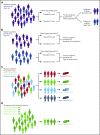Toward personalized treatment in multiple myeloma based on molecular characteristics
- PMID: 30587529
- PMCID: PMC6384187
- DOI: 10.1182/blood-2018-09-825331
Toward personalized treatment in multiple myeloma based on molecular characteristics
Abstract
To date, the choice of therapy for an individual multiple myeloma patient has been based on clinical factors such as age and comorbidities. The widespread evolution, validation, and clinical utilization of molecular technologies, such as fluorescence in situ hybridization and next-generation sequencing has enabled the identification of a number of prognostic and predictive biomarkers for progression-free survival, overall survival, and treatment response. In this review, we argue that in order to continue to improve myeloma patient outcomes incorporating such biomarkers into the routine diagnostic workup of patients will allow for the use of personalized, biologically based treatments.
© 2019 by The American Society of Hematology.
Conflict of interest statement
Conflict-of-interest disclosure: C.P. received consultancy and travel support fees from Amgen and Takeda Oncology; honoraria and travel support from Janssen; and consultancy, honoraria, and travel support from Celgene Corporation. F.E.D. received consultancy and honoraria from Amgen, AbbVie, Takeda, and Janssen and consultancy, honoraria, and research support from Celgene Corporation.
Figures



References
-
- Pawlyn C, Morgan GJ. Evolutionary biology of high-risk multiple myeloma. Nat Rev Cancer. 2017;17(9):543-556. - PubMed
-
- Biomarkers Definitions Working Group. Biomarkers and surrogate endpoints: preferred definitions and conceptual framework. Clin Pharmacol Ther. 2001;69(3):89-95. - PubMed
-
- Dewald GW, Kyle RA, Hicks GA, Greipp PR. The clinical significance of cytogenetic studies in 100 patients with multiple myeloma, plasma cell leukemia, or amyloidosis. Blood. 1985;66(2):380-390. - PubMed
-
- Fonseca R, Debes-Marun CS, Picken EB, et al. . The recurrent IgH translocations are highly associated with nonhyperdiploid variant multiple myeloma. Blood. 2003;102(7):2562-2567. - PubMed
Publication types
MeSH terms
Substances
LinkOut - more resources
Full Text Sources
Medical

